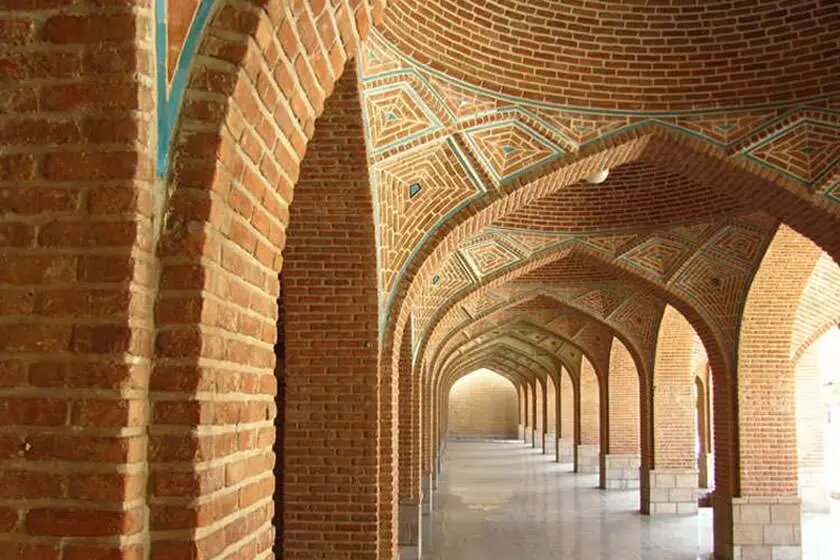Dezful Mosque: an example of Persian architectural mastery

TEHRAN - The city of Dezful, sometimes referred to as the “city of bricks,” is a living museum of ancient Persian architecture, where every alley and corner reveals intricate designs and historical wonders.
One of its cultural heritage is the Jameh Mosque of Dezful, an architectural masterpiece that stands as a testament to the city’s rich history and enduring legacy.
Located in Khuzestan province, this mosque is more than just a place of worship; it is a beacon of art, history, and architectural splendor, attracting tourists, history buffs, and researchers.
Historical significance
The Jameh Mosque of Dezful is one of the oldest mosques in Iran, believed to have been constructed during the early Islamic era. It showcases a unique blend of Sasanian architecture and the traditional vernacular style of Dezful, embodying centuries of cultural and architectural evolution. This fusion is evident in the mosque’s design, which harmoniously combines elements from different periods, reflecting the region’s dynamic history. Over the centuries, the mosque has witnessed several restoration efforts, particularly during the Safavid and Qajar dynasties, which have further enriched its architectural narrative.
Architectural marvel
The mosque is an exquisite example of Persian craftsmanship. The main structure, located on the southern side, is built from stone, providing a stark yet harmonious contrast to the surrounding brick structures typical of Dezful.
The mosque’s large courtyard invites visitors to experience a serene environment, while its architectural elements captivate the imagination.
One of the mosque’s most striking features is its dome, constructed entirely of bricks. This dome not only adds to the aesthetic grandeur of the mosque but also demonstrates the advanced architectural techniques employed by the builders of the time.
The walls, crafted with a mix of cob coatings and bricks, offer excellent thermal insulation, ensuring that the interior remains cool in the sweltering heat of Khuzestan’s summers.
Tile work and calligraphy
The Jameh Mosque of Dezful is renowned for its exquisite tile work, predominantly from the Qajar era.
These tiles are adorned with Kufic calligraphy and intricate geometric motifs, creating a visual symphony that celebrates Islamic art and culture.
The altar, another focal point, features masterful stucco decorations that further enhance the mosque’s artistic appeal. These elements not only serve religious functions but also highlight the mosque’s role as a center of cultural expression and artistic achievement.
Restoration efforts
Throughout its history, the Jameh Mosque has undergone numerous restorations that have preserved its architectural integrity while allowing for modern enhancements. Recent restoration efforts have focused on improving the mosque’s lighting and ventilation, ensuring that visitors can appreciate its beauty in comfort.
By introducing delicate openings in the roof, natural light floods the interior, casting a gentle glow on the ornate tile work and intricate stucco designs. These efforts underscore the commitment to maintaining the mosque as a living monument of Persian heritage.
Minarets and entrance
Estimated to have been constructed in the 12th century AH, the mosque’s entrance and minarets are significant historical features that command attention.
The entrance is a lavish invitation to explore the mosque’s inner shrine, while the minarets stand as symbols of the mosque’s enduring presence in the spiritual and cultural landscape of Dezful. These elements add to the mosque’s historical depth, offering a glimpse into the architectural practices and religious significance of their time.
Tourism allure
For tourists seeking religious sites with genuine elements of Persian architecture, the Jameh Mosque is an essential destination.
The mosque’s inclusion on Iran’s national heritage list in 1936 underscores its cultural importance and ensures its preservation for future generations. Located in one of Dezful’s oldest districts, the mosque is easily accessible to visitors and offers a unique glimpse into the past.
Known for its ancient bridges, charming bazaars, and traditional houses, Dezful offers a comprehensive experience of Iranian culture and hospitality. The city’s brickwork architecture is particularly noteworthy, with many buildings featuring intricate designs that reflect the skill and artistry of local craftsmen.
Visitors can also explore the Dez River, which has historically been a lifeline for the city, providing water for agriculture and a scenic backdrop for leisurely walks. The riverbanks are lined with lush greenery, offering a peaceful retreat from the hustle and bustle of city life.
A gateway to cultural gems
Dezful serves as a gateway to the wider Khuzestan province, a region steeped in history and natural beauty. Visitors can venture further afield to explore the ancient city of Susa, a UNESCO World Heritage site that dates back to the Elamite, Persian, and Parthian empires. The nearby Tchogha Zanbil ziggurat is another UNESCO site, offering insight into the architectural prowess of ancient civilizations.
For those interested in natural wonders, the Zagros Mountains provide a stunning backdrop to the province, offering opportunities for hiking, photography, and exploration of Iran’s diverse landscapes. Khuzestan’s unique blend of cultural and natural attractions makes it a compelling destination for travelers seeking an authentic Persian experience.
AM
Leave a Comment